Overview
This article identifies critical insights and trends that are shaping Central Business Districts (CBDs), particularly in light of evolving work models and urban dynamics. To remain competitive and attractive, CBDs must adapt to:
- Hybrid work preferences
- Enhance infrastructure and accessibility
- Leverage data-driven strategies for informed decision-making
This necessity is underscored by significant office vacancy rates and shifts in employee expectations. By embracing these changes, stakeholders can position themselves advantageously in a rapidly changing landscape.
Introduction
As urban environments evolve, Central Business Districts (CBDs) find themselves at a pivotal moment characterized by rapid shifts in work culture, infrastructure demands, and demographic preferences.
The examination of CBD trends for 2025 unveils a landscape where flexibility and accessibility have transitioned from optional to essential elements for attracting both businesses and residents.
Stakeholders must ask: how can they effectively navigate these complexities to ensure their CBDs remain vibrant and competitive in an increasingly crowded market?
This inquiry is critical as the future of urban centers hinges on their ability to adapt and thrive amidst these changes.
Zero Flux: Daily Insights on Central Business District Trends
Zero Flux delivers daily insights specifically tailored to trends in CBD central business districts, meticulously curating data from over 100 diverse sources. This comprehensive approach ensures that subscribers receive timely information on critical developments affecting the CBD central business district, including the notable 19.2% office vacancy rate and shifting housing market trends.
As we look to 2025, the CBD central business district is confronting challenges such as hybrid work models, with 60% of office employees now expecting flexible working arrangements. This shift necessitates a renewed focus on quality of life and accessibility.
By prioritizing factual information, Zero Flux empowers industry professionals to adeptly navigate the complexities of CBD dynamics, addressing high operational costs and traffic congestion. Ultimately, it serves as a reliable resource for understanding the current landscape and anticipating future trends in real estate.
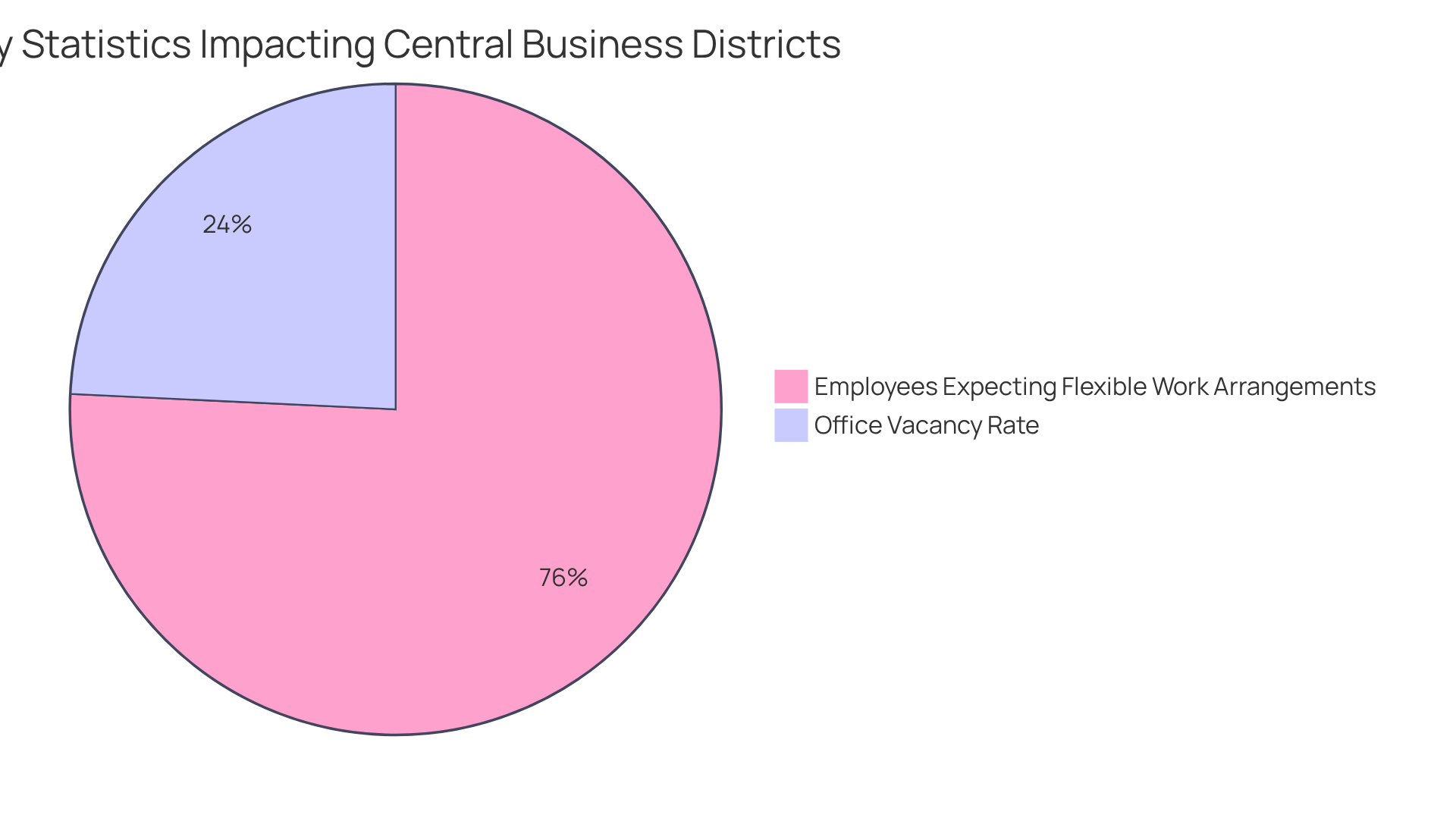
Infrastructure and Accessibility: Foundations of a Thriving CBD
A successful cbd central business district is fundamentally anchored in its infrastructure and accessibility. Efficient public transportation systems, well-maintained roads, and pedestrian-friendly environments are vital for attracting both businesses and residents. In 2025, the average office vacancy rate in the U.S. is projected to be 20.2%, considerably greater than Europe’s 7.6% and Asia Pacific’s 14.7%. This disparity highlights the urgent need for cbd central business districts to enhance their attractiveness through strategic infrastructure investments.
These enhancements not only strengthen connectivity but also elevate the overall quality of life, transforming the cbd central business district into an appealing location for work and leisure. Notably, cities prioritizing infrastructure development, such as the recent $288 million Kangaroo Point Bridge project in Brisbane, are expected to see significant reductions in vehicle traffic. Projections indicate a decrease of 84,000 vehicles annually, thereby enhancing public transport usage.
Furthermore, around 60% of office employees now expect flexible working arrangements, averaging 2.3 days worked remotely each week. This shift necessitates that cbd central business districts adjust their infrastructure to support hybrid work models. As metropolitan centers evolve, the integration of robust public transportation systems becomes increasingly crucial. Successful examples like Midtown Manhattan and Raffles Place in Singapore demonstrate how accessibility—through extensive transit networks and pedestrian-friendly designs—can drive economic growth and attract diverse investments.
Ultimately, the future of the cbd central business district hinges on its capacity to innovate and improve infrastructure, ensuring it remains competitive and vibrant in a constantly evolving urban environment.
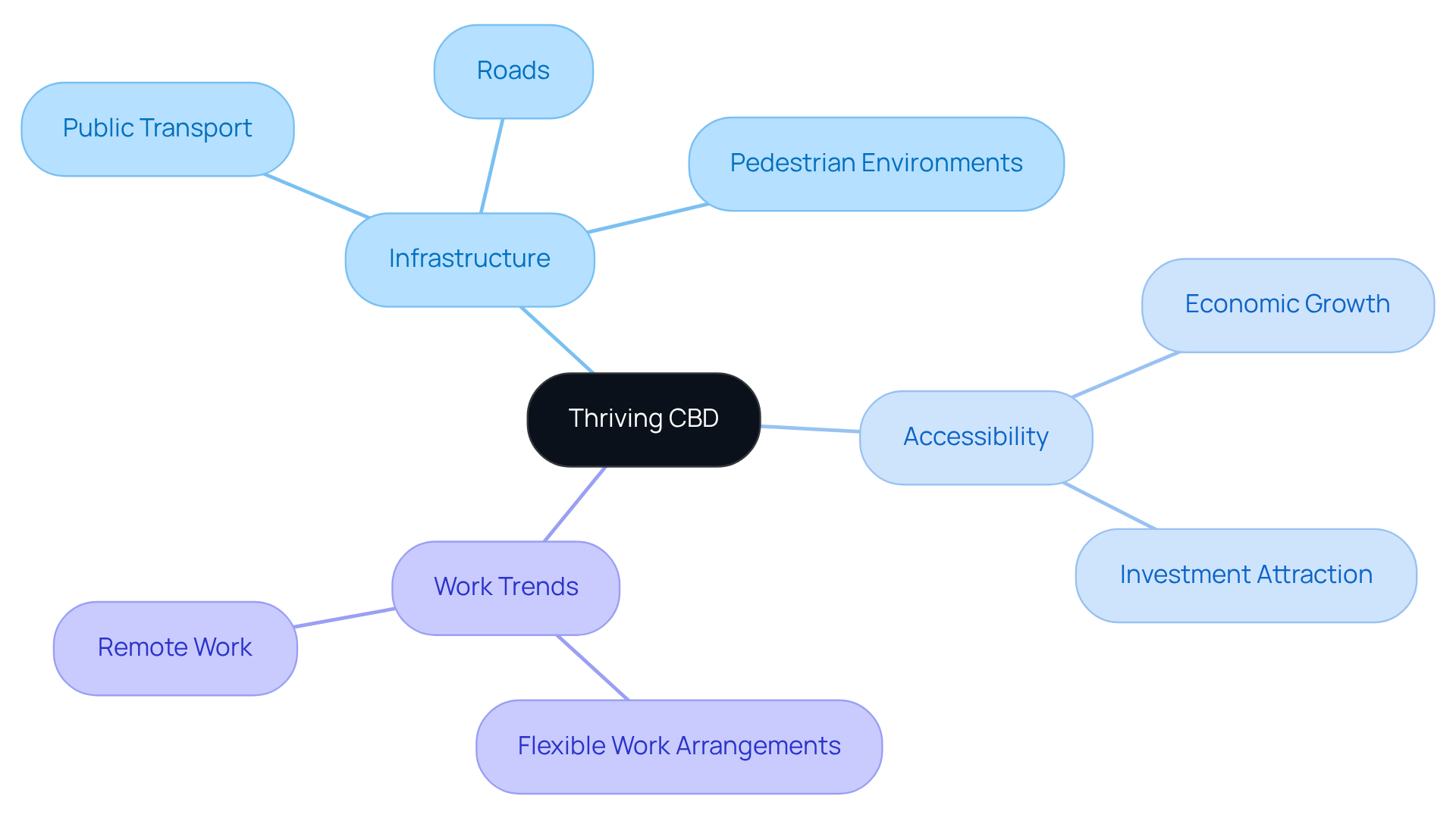
Diverse Business Mix and Amenities: Key to CBD Attractiveness
Central Business Districts, such as the cbd central business district, that showcase a diverse mix of enterprises—including retail, dining, and entertainment—are positioned for greater success. This variety not only draws a wider audience but also strengthens economic resilience. A recent study indicated that families living in these districts reported higher satisfaction levels compared to other demographics, underscoring the significance of catering to diverse needs.
Furthermore, the presence of amenities such as parks, cultural centers, and recreational facilities significantly enhances the attractiveness of the cbd central business district. These features encourage longer visits and repeat foot traffic, ultimately enhancing the overall vibrancy of the area.
Recent developments have introduced innovative amenities designed to attract hybrid workers, demonstrating that even in a post-pandemic landscape, a well-rounded business mix combined with thoughtful amenities can revitalize urban centers and support economic recovery.
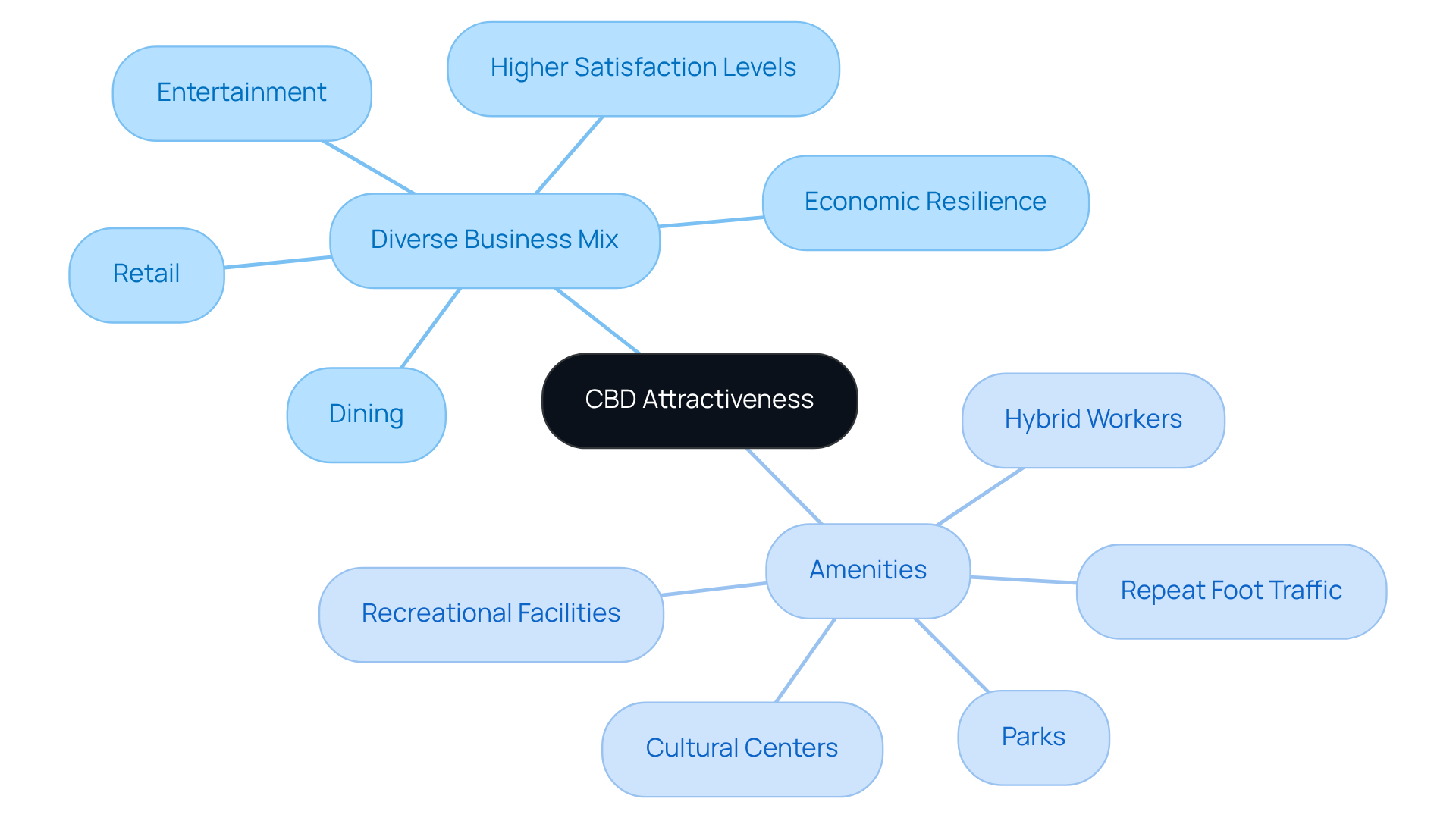
Transportation and Connectivity: Enhancing CBD Functionality
Efficient transportation networks are essential for the functionality of Business Districts. A well-connected CBD (Central Business District) facilitates easy access through public transit, cycling, and walking, thereby reducing congestion and enhancing the overall experience for visitors. Notably, improvements in transportation infrastructure—such as dedicated bus lanes and bike-sharing initiatives—can significantly elevate the appeal of CBDs. These enhancements not only attract more foot traffic but also create a more vibrant urban environment, making these areas more desirable for both businesses and investors alike.
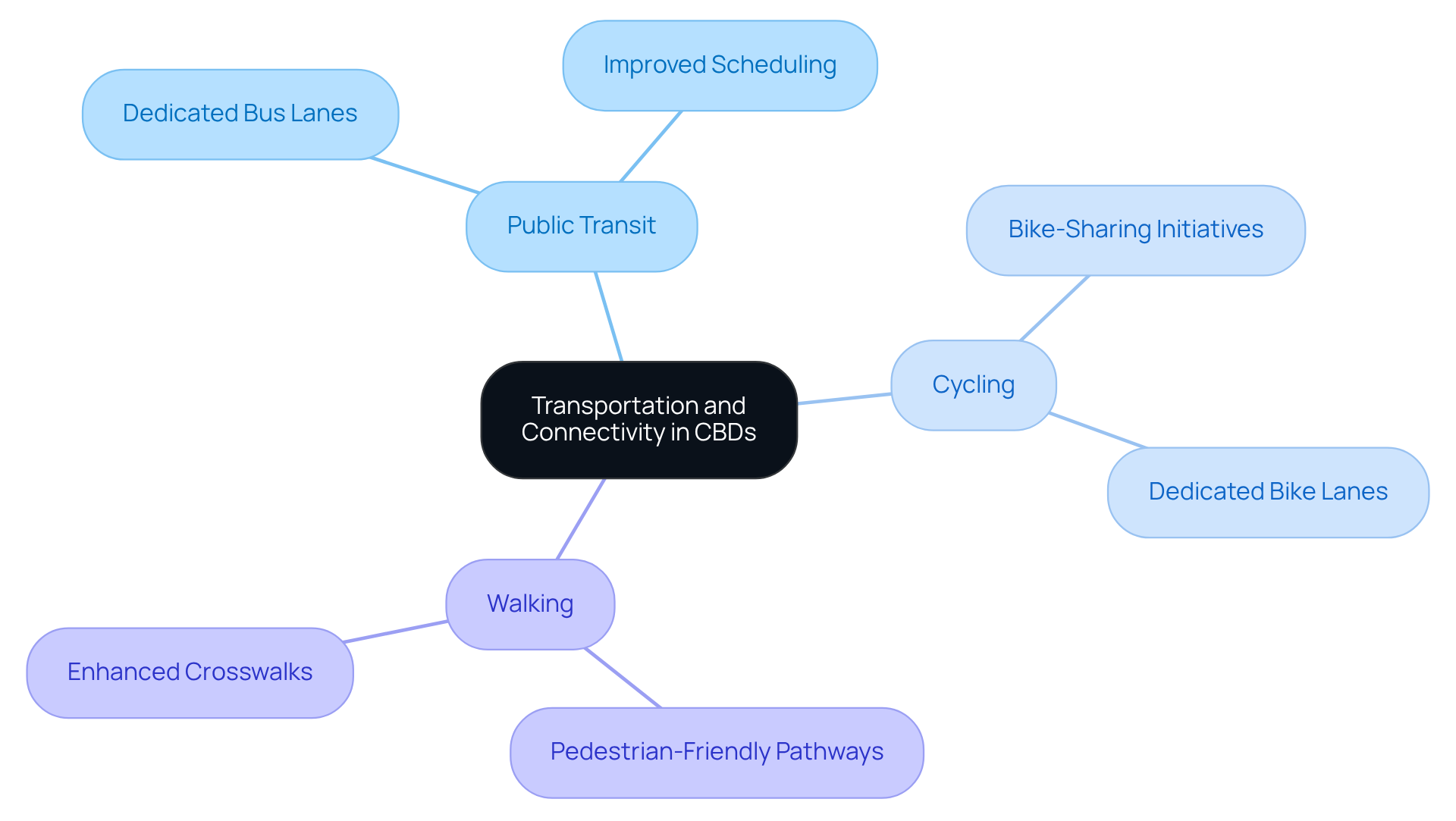
Strategic Investment Planning: Ensuring CBD Sustainability
Strategic financial planning is crucial for the sustainability of cbd central business districts. Stakeholders must consider long-term trends, such as demographic shifts and evolving business needs, to ensure that resources remain relevant. Notably, the integration of green spaces has proven beneficial; studies indicate that urban areas with increased green space experience a 15% rise in property values and a 20% boost in foot traffic, as highlighted in recent research. Furthermore, mixed-use developments are gaining popularity, fostering vibrant environments that attract diverse populations and businesses.
Moreover, the incorporation of technology, including smart infrastructure and digital services, enhances operational efficiency and enriches the overall experience for both residents and visitors. As central business districts, including the cbd central business district, adapt to these transformations, they become more resilient to economic fluctuations, positioning themselves as attractive destinations for investment and development. Successful case studies, such as the revitalization of Fulton Market in Chicago, exemplify how strategic investments can rejuvenate urban centers, making them competitive against emerging districts.
However, central business districts also encounter challenges, particularly with the rise of hybrid work arrangements and competition from new locales. This reality demands innovative planning and sustainability initiatives. By prioritizing these strategies, cbd central business districts can thrive in the evolving urban landscape.
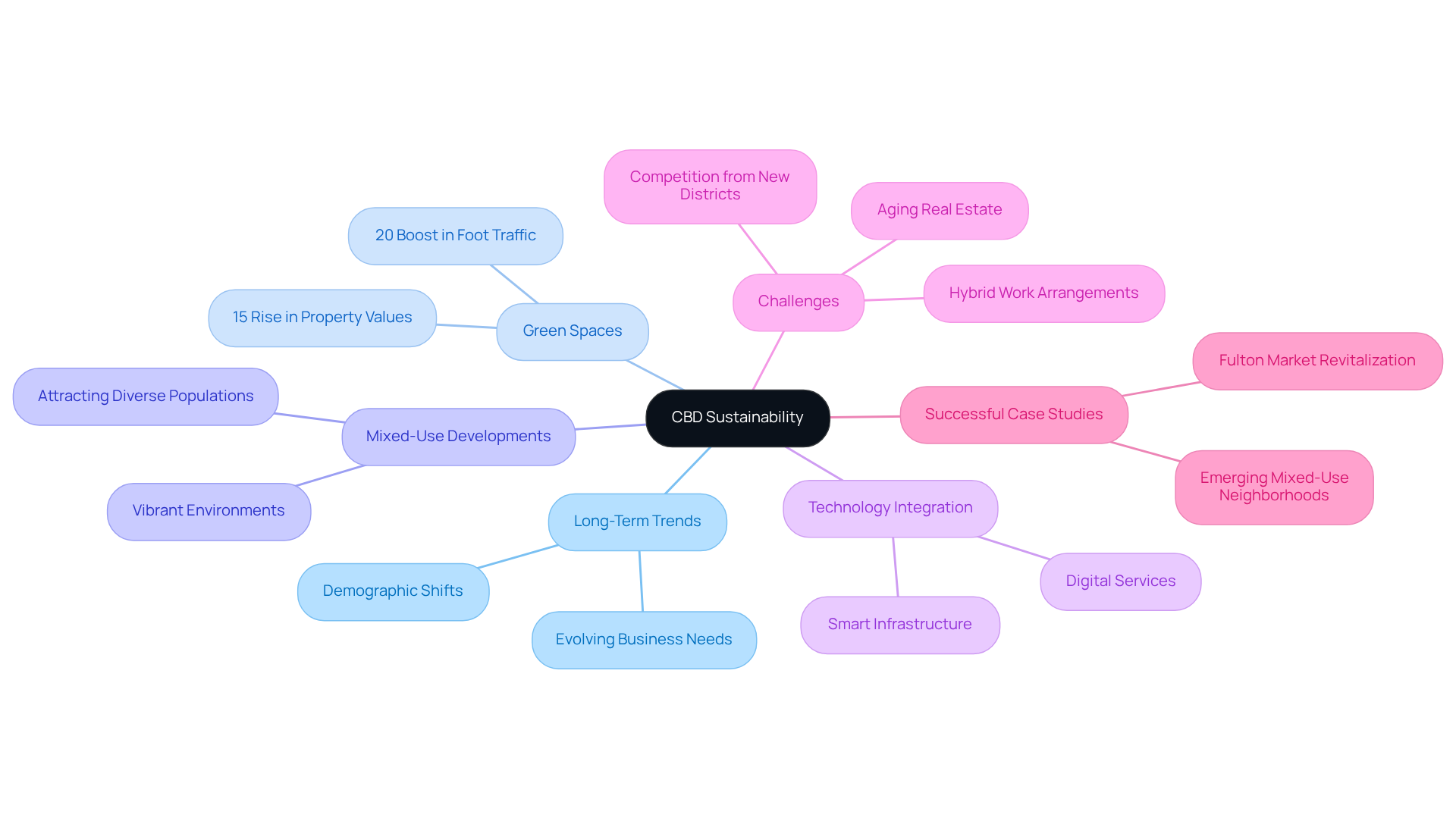
Leveraging Market Data: Informed Decision-Making for CBDs
Informed decision-making stands as a cornerstone for the success of CBD central business districts. By leveraging market data, stakeholders can discern trends, evaluate risks, and execute strategic allocations. Data analytics tools are pivotal in offering insights into consumer behavior, allowing businesses to adjust their offerings to meet the ever-evolving market demands. Notably, organizations that embrace a data-driven culture are three times more likely to report substantial enhancements in decision-making compared to their less data-reliant counterparts, as underscored by a study on data-driven decision-making (DDDM). This reinforces the necessity of integrating robust data analytics into strategies for the CBD central business district, ensuring that investments are not only informed but also in harmony with current market needs.
Successful applications of data analytics tools in the CBD central business district include:
- Geographic Information Systems (GIS), which improve site selection by analyzing local demographics and traffic patterns.
- For instance, Starbucks has adeptly employed GIS to evaluate the potential success of new store locations, empowering businesses to make evidence-based decisions and bolstering their competitive advantage in the vibrant urban landscape.
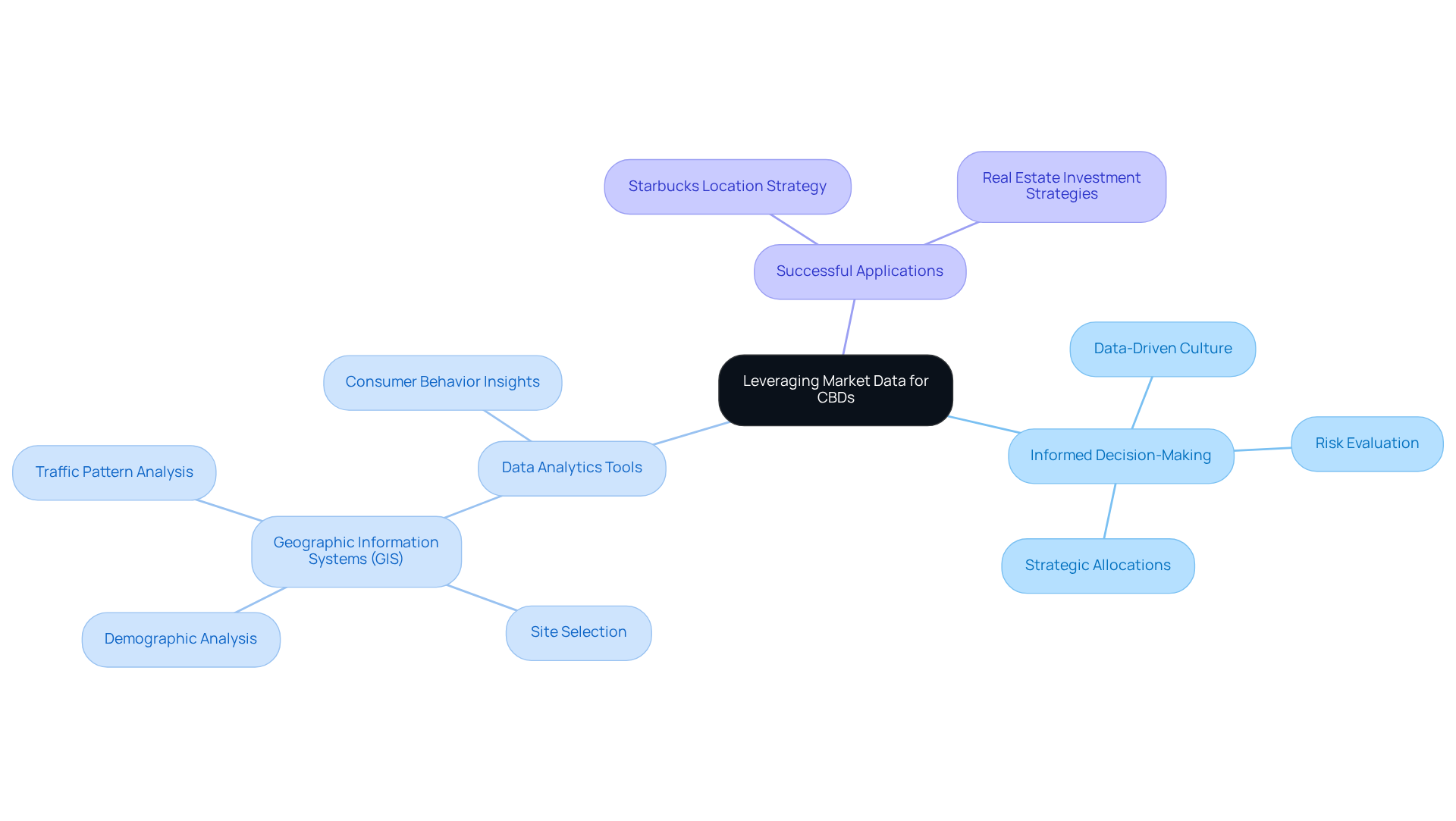
Innovative Approaches and Technology: Transforming CBDs
The incorporation of cutting-edge technologies is revolutionizing the cbd central business district. Smart city solutions, such as IoT sensors and advanced data analytics, are optimizing traffic management, enhancing public safety, and improving resource allocation. These advancements not only streamline operations within the cbd central business district but also create a more vibrant and engaging atmosphere for both residents and visitors.
Furthermore, case studies from cities like Miami, which is leveraging digital twin technology for city planning, illustrate how these innovations can lead to smarter, more sustainable environments. As cities increasingly embrace these technologies, experts underscore the critical need for digital transformation to bolster economic development and elevate the quality of life for inhabitants.

Urban Trend Analysis: Identifying CBD Opportunities
Urban trend analysis is pivotal for uncovering opportunities within the cbd central business district. By closely monitoring demographic shifts, economic indicators, and consumer preferences, stakeholders can effectively identify areas ripe for growth and development. For instance, from 2016 to 2021, downtown populations in Canada increased by 10.9%, significantly surpassing the total city growth rate of 6.1%. This trend underscores the rising population density and the shift towards central living, driven by factors such as improved housing availability and a desire for shorter commutes.
Moreover, the 2021 Census revealed that 73.7% of Canadians resided in major metropolitan areas, up from 73.2% in 2016, indicating a robust demand for city living. As urban centers expand, understanding these demographic dynamics becomes crucial for the cbd central business district to adapt and thrive. Notably, Halifax's downtown population surged by 26.1%, part of a broader trend where 36 out of 42 downtowns experienced population increases, highlighting the investment potential in rapidly growing urban areas.
This proactive strategy empowers cbd central business districts to remain competitive in a changing market landscape, ensuring they can meet the evolving demands of residents and businesses alike. Nevertheless, it is essential to recognize the challenges faced by CBDs, such as high vacancy rates, which reached 19.2% in April 2025, and the shifting demand towards suburban locations. By leveraging data-driven insights, stakeholders can make informed decisions that capitalize on emerging trends, ultimately fostering sustainable urban development.
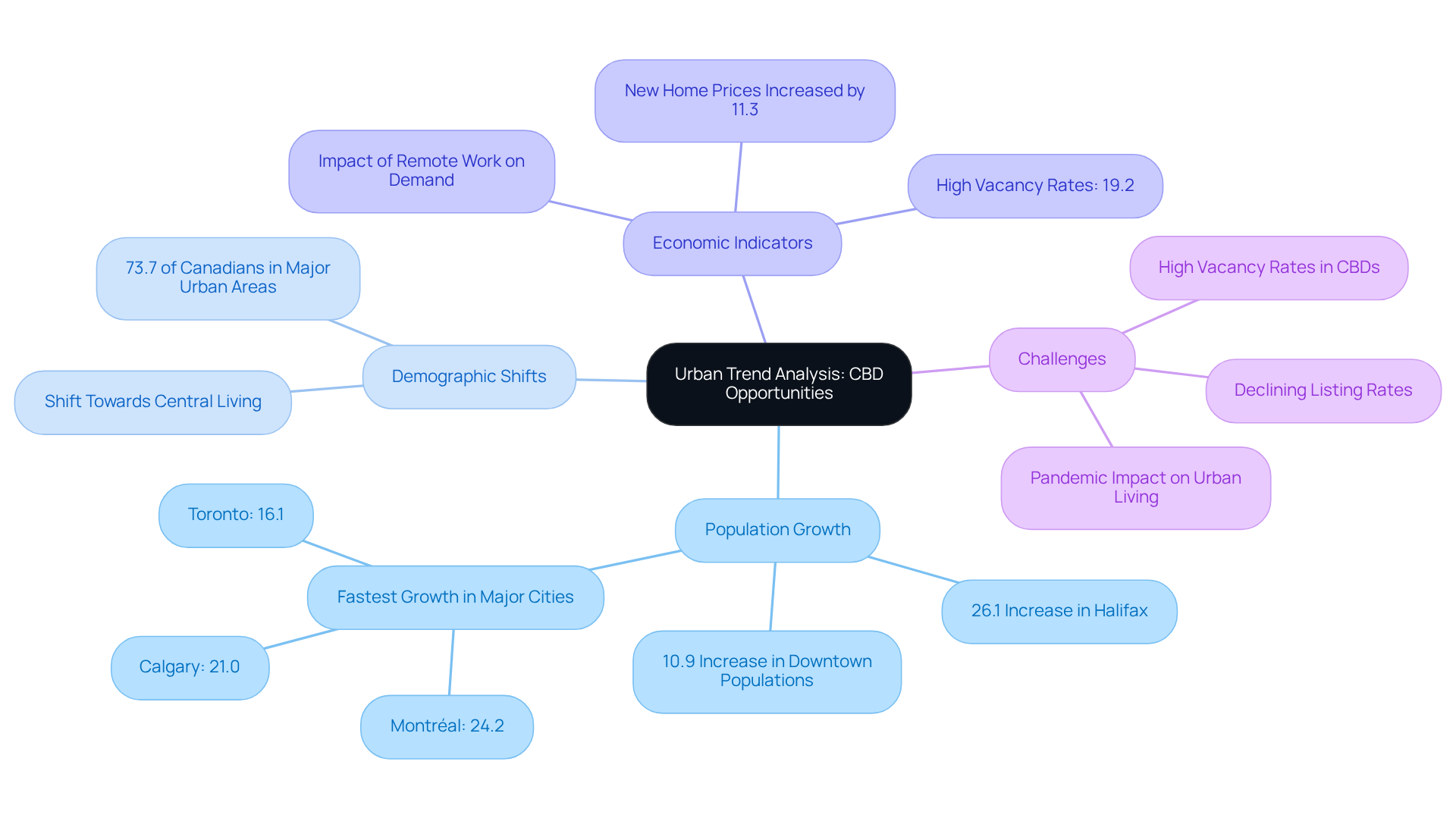
Competitive Analysis: Positioning CBDs in the Urban Landscape
Understanding the competitive landscape is essential for effectively positioning Business Districts. By examining neighboring districts and their offerings, stakeholders can pinpoint market gaps and formulate strategies to elevate their Central Business District's appeal. This competitive analysis not only informs marketing strategies but also guides investment decisions, ensuring that central business districts continue to attract both companies and consumers. In a rapidly evolving market, recognizing these dynamics is crucial for sustained success.
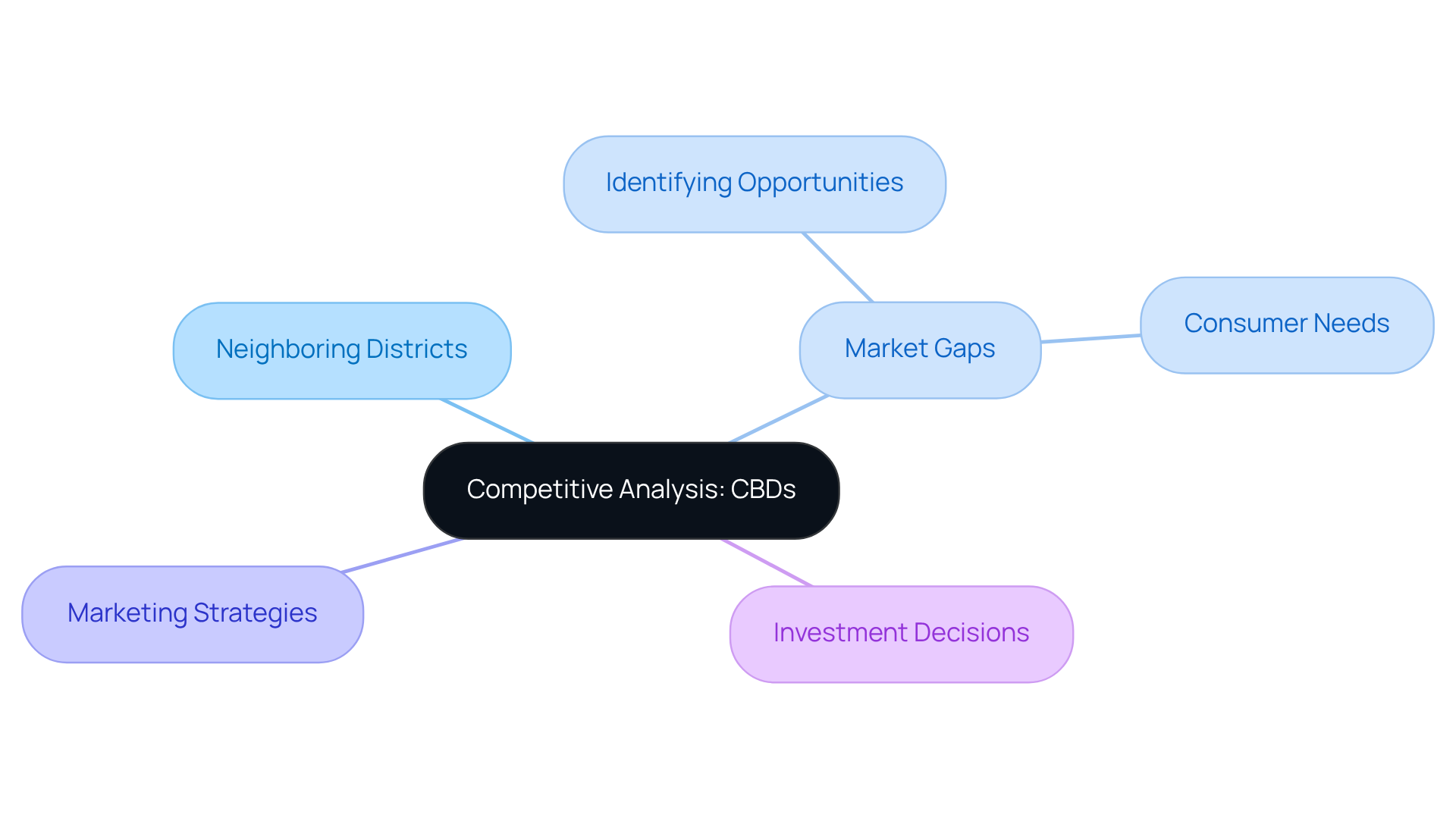
Future Predictions and Growth Opportunities: Planning for CBD Success
Planning for the future of the cbd central business district requires a deep understanding of growth opportunities and market dynamics. With remote work becoming a permanent fixture—approximately 60% of office employees expect flexible arrangements and average 2.3 days of remote work weekly—cbd central business districts must adapt their strategies to attract and retain talent. This transformation emphasizes the importance of enhancing quality of life, which has emerged as the primary consideration for employees when selecting their workplaces. Lengthy and costly commutes to the cbd central business district are increasingly unattractive, highlighting the need for these areas to cultivate environments that prioritize convenience and accessibility.
Sustainability plays a pivotal role in shaping CBD strategies. More than 1 billion square meters of office space globally will require retrofitting by 2050 to meet energy efficiency targets. CBDs must focus on upgrading outdated buildings to avoid obsolescence and preserve capital value. The urgency for retrofitting is amplified by the necessity to triple current rates from 1% to 3%-3.5% annually. Notably, U.S. office vacancy rates currently sit at 20.2%, significantly exceeding Europe’s 7.6% and Asia Pacific’s 14.7%, highlighting the challenges the cbd central business district faces in attracting tenants and maintaining occupancy.
Emerging mixed-use neighborhoods are reshaping the landscape, drawing businesses and investments away from traditional CBDs. To thrive, successful cbd central business districts must reinvent themselves by embracing vibrant, amenity-rich environments that cater to the evolving preferences of both workers and residents. Case studies indicate that collaboration between public and private sectors is essential for developing sustainable city centers capable of addressing economic, environmental, and demographic challenges.
By proactively embracing these trends and prioritizing adaptability, CBDs can secure long-term success and resilience in an ever-evolving urban environment. A commitment to data integrity and credible sourcing will further bolster the authority of the insights presented, ensuring stakeholders are well-informed in their planning endeavors.
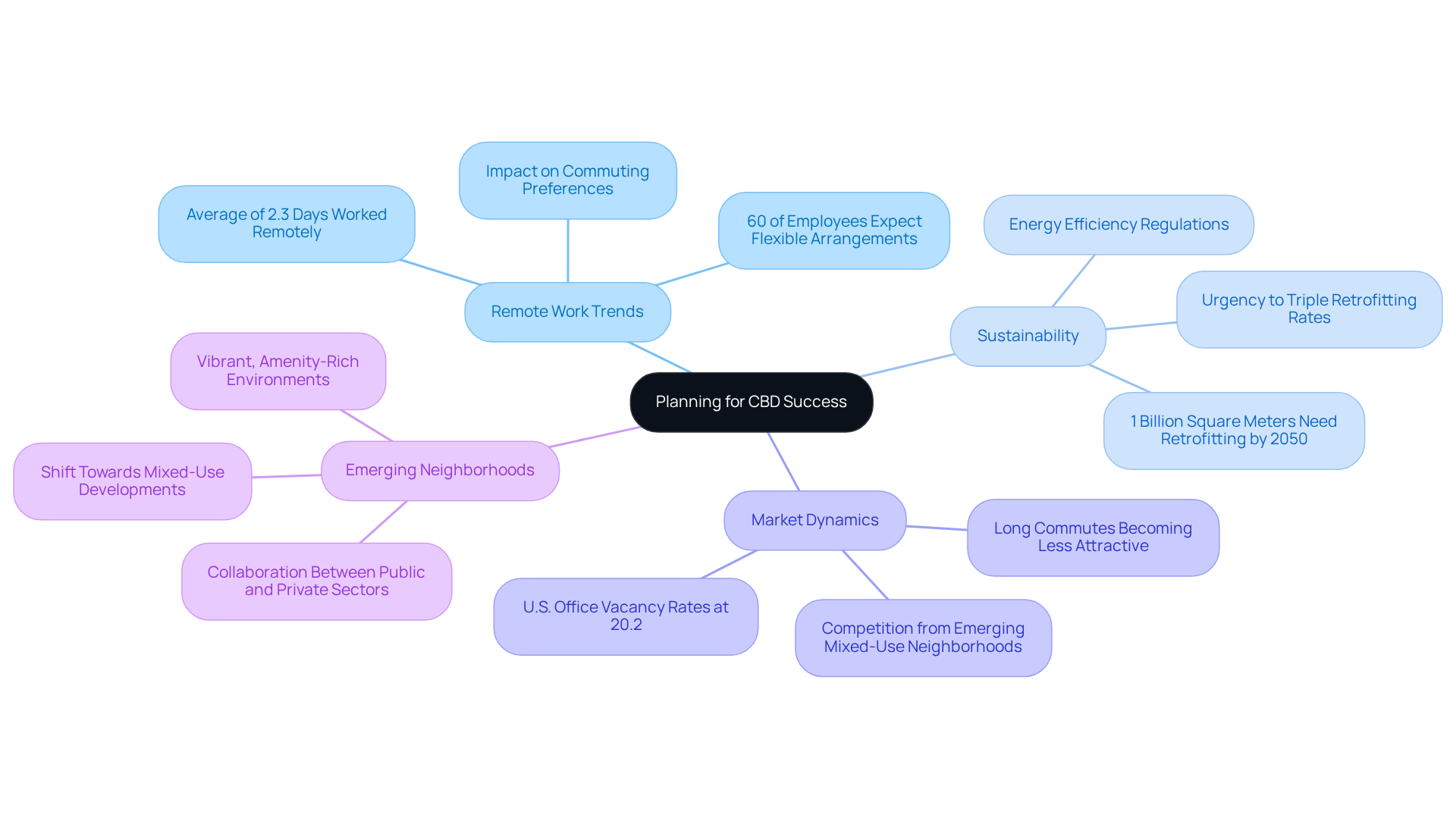
Conclusion
The evolution of Central Business Districts (CBDs) is increasingly shaped by dynamic factors such as:
- infrastructure
- accessibility
- diverse business offerings
- innovative technologies
As the landscape shifts, it is crucial for stakeholders to grasp these elements to navigate the complexities of urban development effectively. The insights presented underscore the pressing need for CBDs to adapt to changing work models, enhance the quality of life, and prioritize sustainability to remain competitive and vibrant.
Key arguments throughout the article emphasize the significance of:
- strategic investment in infrastructure
- the importance of a diverse business mix
- the role of data-driven decision-making in shaping successful CBDs
The discussion on transportation improvements and the integration of technology illustrates how these factors collectively contribute to a thriving urban environment. Furthermore, the need for proactive planning in response to emerging trends and demographic shifts highlights the urgency for CBDs to reinvent themselves to meet the expectations of modern residents and workers.
In light of these insights, stakeholders are encouraged to embrace innovation and collaboration, ensuring that their CBDs not only attract businesses but also foster a sense of community and well-being. By prioritizing strategic investments and leveraging market data, CBDs can position themselves for sustainable growth and resilience in the face of evolving urban challenges. The future of Central Business Districts hinges on their ability to adapt and thrive, making it imperative for all involved to take action and contribute to this transformative journey.




